My mailbag has been full for the better part of four months, so I figure I better keep my promise to all of you and reply in print to some of the best questions.
Here’s a letter from reader Alan in New Jersey:
Dear Jay:
I want to visit or vacation in all 50 states, but I’m married. That means I have to save the vacation states like California, Hawaii, and Florida for my family, but I can visit the weirder states for golf. What do you have in the Pacific Northwest that you recommend? Did you see anything good when you were out there for the U.S. Open?
Alan in New Jersey
Dear Alan:
I like your wording…"the weirder states.” I’m wondering if I can guess why you call Washington “weirder.” (Kidding! Kidding!)
Colorado and Washington jokes aside, I had a downright epic time in the Evergreen State. When I showed up at the Seattle marina and had that giant yacht waiting for me as my crash pad for the week, I felt like Al Czervik from "Caddieshack"! (Insert Rodney Dangerfield voice: “Ahhhhhhhh! Move over, Swanson, I’m driving!”)
And by the way, here’s a trivia question for you: What was the name of Czervik’s yacht in the movie? (Answer below)
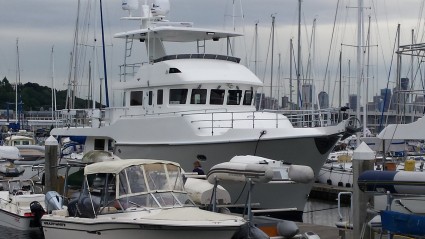
Das Boat (as I like to call it) was just the beginning, as the golf courses were equally phenomenal (as was my flash mob posse). A golf trip around Washington state rivals any other state in the union, even North Carolina or Colorado when it comes to that combination of great golf architecture and stunning natural setting that true ardent golfers and connoisseurs search for so diligently. Besides Chambers Bay, I visited the two next best public northwest venues north of Bandon Dunes -- Wine Valley and Gamble Sands. I also had an unforgettable day at Coeur D’Alene, the world-famous lakeside resort just over the Idaho border, with its famous “Flopating Green.” And I would be remiss if I also didn’t mention Palouse Ridge, which though I haven’t played it yet, its reputation as a course of merit has spread equally far and wide.
CHAMBERS BAY
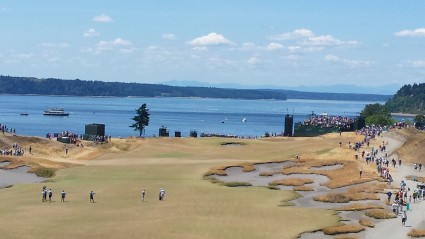
Chambers Bay plays so much better than it looked on TV; I feel bad for the viewing pubic who were incessantly ordered by broadcasters to dislike it. Once again, it shows that TV is preconditioned, afraid of change and only likes things they’ve seen before. Ironically, the very same features we were told to genuflect to at Pinehurst – biscuit brown fairways, rugged bunkering off the fairway, and curvy greens – are the same things we were told to deride at Chambers Bay. Is it because one is 108 years old and the other eight? Or is it because one is by Donald Ross and the other by Robert Trent Jones, Jr.?
I’ll say “Sorry, not sorry” to the naysayers, and you should, too, because Chambers Bay ranks highly among the great links of the world, a proud and proper American rejoinder to St. George’s, Royal County Down, St. Enodoc or even fabled Ballybunion. It may be young, and it may have the distinction – some erroneously say flaw -- of having the most elevation change of any of the great worldwide links, but those that portray that as a negative are horribly, horribly wrong. Despite what you heard on ESPN, links courses are not supposed to be flat, as the courses listed above clearly demonstrate.
But more importantly, Chambers Bay has indelible and irrepressible character. Its holes are exciting, unique and memorable, whether it’s the murderous stretch of par 4s from four through seven (known colloquially as the Bermuda Triangle) or the roller-coaster finish of Nos. 15-18. Best of all with its firm fast fairways, which blend perfectly seamlessly into the greens, it plays like a links. In fact, it plays like an Open rota venue that hasn’t been homogenized by malcontent pros whining about the wild links bounces everyone else has to overcome.
Perhaps the most indisputable truth about Chambers Bay came from Robert Trent Jones, Jr. himself, the architect of Chambers Bay (not Jay Blasi, as some in the “every participant gets a trophy” crowd have incorrectly asserted):
“People need to know how to read the golf course; there are lot of ways to play the holes – bump and run, aerial, and ways in between,” he explained. “The moaning doesn’t bother me. Most people don’t like something that’s new. It takes time for them to get used to it.”
Unquestionably -- almost all great art initially confuses the critics because they can’t put it into one of their convenient little boxes. But you watch, Alan. Once everyone’s done crying like Nancy Kerrigan, golf fans and travel junkies will anoint Chambers Bay as royalty, and the same people who panned it initially will fall all over themselves telling us how they loved it all along.
We here at Golf News Net extend our condolences to the Chambers Bay extended family on the loss of assistant general manager Jamie Fay, killed in a tragic accident when a windblown tree crashed onto his car. We will keep you all in our prayers.
WINE VALLEY
But Washington public golf is far more than just Chambers Bay. The cottage industry of building links courses on sandy soil wherever it is found –- golf design’s hottest trend for the best of reasons -– has resulted in a cornucopia of great links designs springing up in the most unlikely places, and the tour of the absolute best public golf in the state takes us on a journey back and forth to the Idaho border, but also back in time more than 100 years, architecturally speaking.
It’s a five-hour drive across the state from Seattle to Walla Walla but the road trip is among the most scenic in America, traversing no less than five distinct and variegated ecosystems. The road first climbs into the mountains and past two of Washington’s ski resorts, then extends across high desert, past rugged, rolling hilltops and verdant gorges, through a hillside pass where a city in a valley lies sleepily beneath you, tucked cozily in the vale. Finally, you arrive in wine country and Wine Valley, a true links layout spoken of in the same holy whispers as Bandon Dunes and Ballyneal.
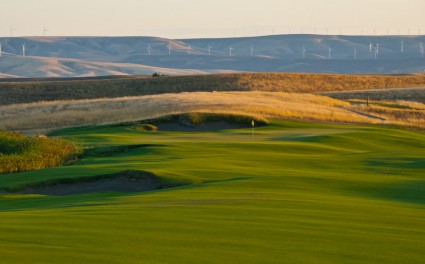
Indeed, many call Wine Valley “a public Ballyneal,” and the similarities are striking. Both courses are in the middle of nowhere. They were shaped by, essentially, the same team of shapers that worked at Ballyneal, minus Tom Doak, of course. Both courses have wild, hurly-burly greens with fierce contours. Both have a bold, natural look complete with blowout bunkers. Both are built over enormous areas (Wine Valley is spread over 300 acres), yet both are minimalist in design, hardly any earth was moved during construction. Both courses play fast and firm. And both courses have an ardent cult following; each is the stuff of holy whispers by and among the golf cognoscenti.
“The beauty of Wine Valley is that from every square foot of that property you could make a good golf hole in any direction,” stated a rightfully proud Dan Hixson, lead architect on the project. “We didn’t just want to just build up and down the valleys, and we didn’t want repetition. We wanted to use the valleys in different ways,” he continues. “Fairly late [in the round] we used the wash which goes down 12, across 14 over to five, and across the fairways. That’s a man-made feature that works strategically and drains the rain and snowfall. It looks natural and it works for all those holes.”
While every fairway slithers serpentinely around, through and even over the valleys, requiring strategic analysis on every shot, the par-5s are the showstoppers. All of them offer players of most skill levels a chance to reach the green in two, yet the bunkers are deep and penal.
“Those holes offer great risk-reward options,” said local player Ken Cole. “You can catch up in match play matches. Plus, the greens are fantastic.”
Yes, they are -- indeed, the greens are the sturdy backbone of the course, with undulations so hurly-burly, they’ll have you meandering around their hollows like a drunkard who had too much of the rightfully famous local wine. Happily, they keep the surrounds as shaved chipping areas, so you have every option around the greens; bump and run, pitch and check, putt, or pitch.
"[Shaper kye goalby] was part of the crew that did the greens at Ballyneal, and he’s a bold shaper,” states Hixson, with a chuckle and a twinkle in his eye, fondly recalling his friend’s penchant for creativity and thinking outside the box. “I never told him to turn down the volume. We never made one bland green and then one really crazy one, they are all crazy! Lots of movement! Ken is one of the big reasons they are so good. I recognized really quickly that Kye had a lot of talent and I said 'Let him go! Let it roll!' I’ll just edit him, and we’ll be fine.”
Fine isn’t the word – magnificent is. Wine Valley became an instant classic, appreciated by all who have played her as being the state of the art of the craft when it comes to modern links, a course of national and architectural significance. Yet due to its remoteness - enough off the beaten path that only the most intrepid golfers make the trek to Walla Walla – there’s still a lot of prestige for those who get to play it before it becomes a household name.
PALOUSE RIDGE
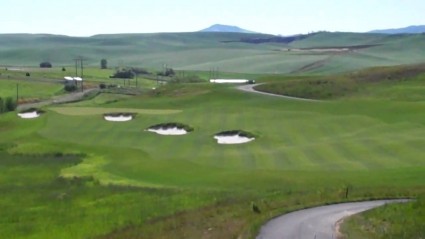
Just a short hop away in Pullman, the late John Harbottle designed what is regarded as not only one of his finest courses, but one of the best in the state in Palouse Ridge. Until his life was tragically cut short by a heart attack in 2012, he was Washington’s favorite son when it came to golf architecture. The scion of one of the great female players of her age, Pat Lesser Harbottle, John learned golf architecture at the elbow of no less a personage than Pete Dye. He was also roommates with Tom Doak during the time Doak also worked with Dye.
“Pete taught me all about routing a golf course and about balancing lengths of shots and directions of shots, and requiring fade off the tee and draw into the green on one hole, and then draw off the tee, fade into the green on the next,” Harbottle stated energetically, in an interview with your author shortly before his death. “And he taught me to keep the ground game in play. Keep fairways wide, but require there to be a right side and wrong side of the fairway.”
The terrain at Palouse Ridge is outstanding: rising and falling, wildly undulating, and fast and firm. And as for the bunkering, golf architecture expert Mark Saltzman once observed that the bunkers all seem to be exactly where you want to hit the ball. (Which is precisely where they’re supposed to be; that’s great golf architecture.)
Some detractors whine that it’s a tough walk and yes, it’s a little hilly in places, but a reasonably healthy golfer should find the walk stimulating, but not exhausting. I think the bigger drawback might be a bit of repetition – Harbottle liked to start off too many holes with “a dip and a rise” – objectionable not because it’s a mildly blind shot, but simply because he tended to pull that arrow out of the quiver too often to start his par-4s and par-5s, and it gives the holes a feeling of sameness, at least off the tee.
Most importantly for golf vacation purposes, it’s in close proximity to Wine Valley – you might even be able to play both courses in the same day. Happily, it’s also near…
COEUR D’ALENE
I know! I know! This is supposed to be an article about Washington golf and Coeur D’Alene is in Idaho, but everyone needs to visit the resort once in their life. It’s just 45 minutes from Spokane, making it a must “add-on” to any trip to the region. Golf architecture aficionados may turn their nose up at the famous “Floating Island Green” – attached to the mainland by an underwater system of pulleys that move the 10,000 square foot green around the lake - but everyone else thinks it’s fun and looks forward to the boat ride to and from that green all day long.
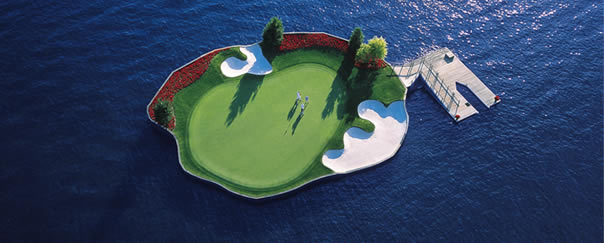
“The grass really is that green, and the water really is that blue,” said traveler James Kaye, and he was right.
Plus the air is like wine. In high summer it’s a glorious setting: dazzling sunlight dancing off the sapphire waters with the verdant, tree-covered hills framing the scene serenely.
The Scott Miller-designed golf course is far more than just the par-3 14th. The front side also visits the edge of the lake, playing to and along the water in the middle of the front side (three through seven are a thrilling stretch) before tacking back inland. The par 5s on the back traverse rumpled fairways, linking the waterfront to the forest, before playing thrillingly back to the clubhouse. It’s also short and comparatively easy, so resort guests can have their egos stroked by a good score so long as they don’t hit the ball sideways on the lakeside holes. By the way – if you ask, after 4:00 p.m., they sometimes put the floating green in motion while you’re hitting. You can watch the digital counter on the tee box click down to a distance you like. 138…137…136…135…BINGO! 8-iron! For those that ride, you can also get golf carts that have stereos in them, so can crank tunes on the course a la Al Czervik. And that’s another trivia question for you! What song did blast at Bushwoods after shouting at DeNunzio, “So what? So let’s dance!”
Everything else about the resort sparkles as well, from the rooms to the food to the myriad other sporting activities. The entire ethos is one of a restorative elixir. Coeur D’Alene is one of hose places you remember visiting for the rest of your life.
GAMBLE SANDS
I know I’ve taken you across the state, but the journey back to Seattle will be divided almost exactly in half as we hit our last course on the tour, Gamble Sands, a brand new David McLay Kidd course perched high above the bluffs of the Columbia River near Brewster.
It’s a majestic setting: 400 acres spread across the gorge’s edge, greens clinging to clifftops, the North Cascade mountains looming off in the distance. More importantly, the Gebbers family, one of the country’s biggest names in the cherry and apple industries, tapped into the zeitgeist when they hired Kidd to make the course’s design reflect the best features of the land so exquisitely. Kidd, as you recall designed Bandon Dunes, the first course at the giant multiplex which took the golf world by storm in the last 15 years. On a plot 1,700 feet above sea level, where the wind whips across fairways ruthlessly, he built an out-and-back routing with wall-to-wall fescue. Fairways, like Wine Valley, have a wonderful horizontal sweep from side-to-side, so diagonal angles abound.
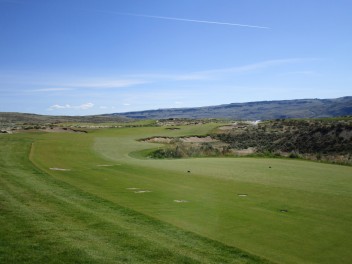
“It’s completely minimalist - many fairways were never touched by bulldozers. All we did was cut the bunkers,” explained course superintendent Chip Caswell. The course is eminently natural, yet remarkably strategic.
“We have a lot of half-par holes here with many ways to play these golf holes, and it’s the swings that make this course so fun and interesting,” he continued. “Though there are three drivable par 4s, you have to choose your lines carefully, because there’s also 15 acres of sand out there.”
That’s an understatement because many of those bunkers are either 15 feet deep or more or narrow trenches just large enough to fit the proverbial angry man and his wedge. Thank goodness the fairways are sometimes 90 yards wide!
While most golfers are spellbound by the time they reach the second green – clinging precariously on the edge of the river with the entire valley spread out in the distance - your author prefers the stretch of 5-8, where yawning chasms of bunkers so deep you need repelling equipment to get in and out of them can swallow golfers whole. Also the perpendicular ravine that bisects the 14th fairway and the bowl green of the 16th are can’t miss architectural highlights, while the rugged, rumbling terrain bleeds so seamlessly into the greens, it’s imperceptible where one ends and the other begins.
It’s another runaway smash hit for Kidd – Gamble Sands does everything right. It’s promotes the ethos of the game with natural, mininalist concepts, while thrilling the golfer with UK-like terrain and brilliant golf puzzles to solve. It’s a thinking man’s course in a supermodel’s body. And who can’t love that?
EPILOGUE
So there’s your next golf trip, Alan: Apples, cherries wine…mountains, gorges, rivers, lakes…resorts, mom-and-pop courses, and a U.S. Open venue. You’re welcome!
Al Czervik’s yacht in Caddyshack was called was called Seafood.
The song he cranked so loudly that Judge Smails had to yell, “CUT…THAT…OUT! MUSIC IS AN INVASION OF OUR PERSONAL PRIVACY!” was Journey’s “Any Way You Want It”.

